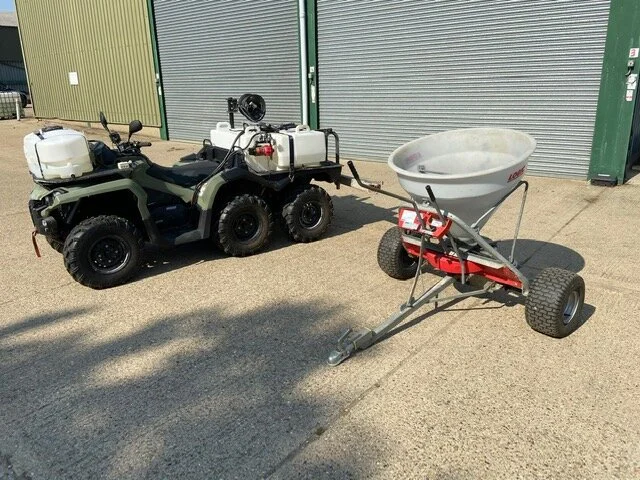
Cozens Wiley have years of experience in the provision of grass care and weed control to the equine industry.
We are able to provide a comprehensive paddock service to both tenants and freeholders.
With a primary expertise in spraying and grassland management, we are able to provide a wide range of additional services.
Weed Control
Weed control is our specialty. At Paddock Services we guarantee all our work, and will not charge you if a second visit is necessary.
Weeds are one of the main problems that many horse owners face, they can not only provide competition for grass but also can be harmful to your animals and impact their wellbeing. Weeds such as Ragwort are incredibly invasive and toxic to horses and must be controlled under the poisonous weeds act 1959. Plants such as docks, thistles, and buttercup can all impact the health of a horse’s diet and cause infections such as laminitis. As we say, happy paddocks lead to happy horses.
The normal time of the year to spray ranges from late March to late September and is where the majority of our work takes place. We are able to spray for all unwanted weeds using animal friendly, non-toxic herbicide from a trusted supplier.
Ragwort
Poisonous to horses. Common Ragwort contains potentially deadly pyrrolizidine alkaloids. These toxic compounds principally cause damage to the liver that can lead to death. Under the the Control of Ragwort Act (2003) it is expected that all landowners, occupiers and managers will co-operate and take collective responsibility for ensuring that effective control of the spread of Ragwort is achieved.
Creeping Thistle
Must be controlled under the poisonous weeds act 1959. If left, it can soon take over your paddock or lawn.
Harrowing
Harrowing
is mainly done during the spring and autumn and is a key part in your paddock maintenance schedule. We use a wide, spring tined harrow in order to get the best from your grass. harrowing has many benefits;
Removes dead grass, thatch, and any moss from the surface and prevents your grassland from clogging up. This allows the soil and grass to breath and allows the maximum amount of light to get to the grass, without the competition from plants such as moss. This encourages strong, healthy growth.
Spreads out any piles of horse much that may have built up over time. This not only removes the not so attractive piles, but also fertilises the fields while spreading.
The Quality
of your soil is one of the most important factors in achieving the best out of your grass. Whether you are wishing to repair overgrazed and tired paddocks, struggling lawns, or just simple grassland, fertilising significantly helps create good quality grassland. By fertilising you ensure that you have a sufficient amount of nutrients and minerals present such as nitrogen, phosphate, potassium pot ash and sulphur while keeping the pH level of the soil in balance. We use a balanced mix of nitrogen, phosphate, potassium pot ash and sulphur. We also use a calcium mix which is best used for grass meant for horses as it facilitates slower growth which makes sure that the horses are not overfed.
Allows for a greater volume of grass to grow and thus prevents overgrazing - a major factor in weed growth
Healthy, strong grass that is more resilient to environmental shocks such as drought and frost
Helps develop taller, less sugar dense grass which is less likely to cause laminitis in your horses.
Fertilising
Drilling and reseeding
If your horse's paddock, or garden
is looking a little bare after the winter, or overtrodden patches have started to appear you might want to consider reseeding it. Reseeding takes a bit of planning – horses shouldn’t graze on new grass until it is well established – so we advise that you allow for another space for your horses to graze while the grass establishes itself.
If you are starting from scratch or are wanting to start over with your existing paddock we also offer a complete reseeding service. If you are having consistent problems with patchy grass it is sometimes better to start over, form a suitable base, and seed it with the most appropriate grass.
High quality, calibrated machines ensure the most cost efficient solution
Wide variety of grass available
Giant Hogweed
We also Specialise
in the spraying of giant hogweed. Hogweed can reach over 3m (10ft) in height. Although this striking plant can be attractive in certain situations, it is potentially invasive and the sap can cause severe skin burns. It is widely distributed in the wild and poses a serious risk to people and animals who are unaware of its potential for harm. In the UK, the Wildlife and Countryside Act 1981 makes it an offence to plant or cause giant hogweed to grow in the wild. We therefore actively encourage that any Giant Hogweed growing on your land be sprayed in order to reduce the potential harm it could cause to people and animals around you.











